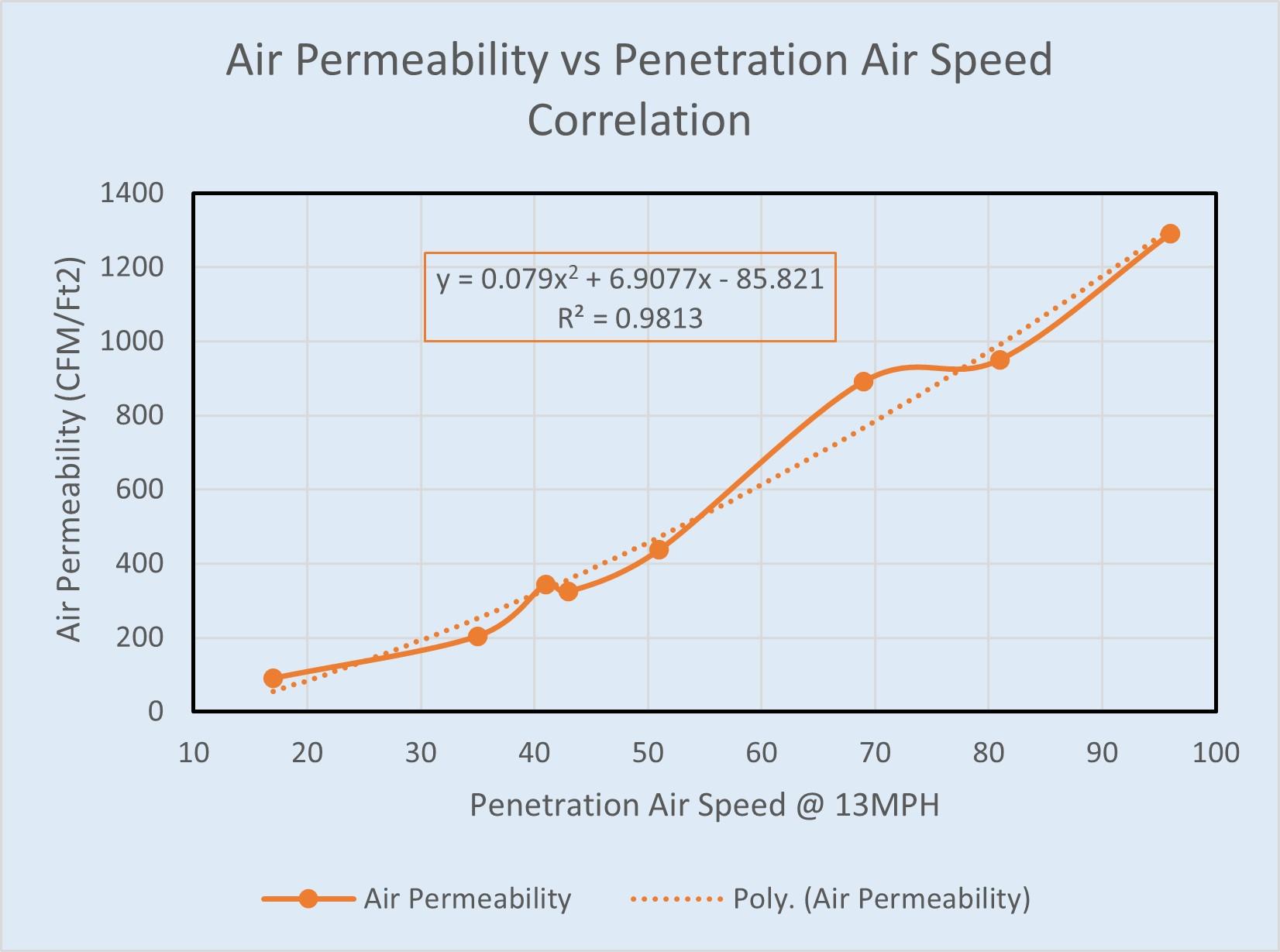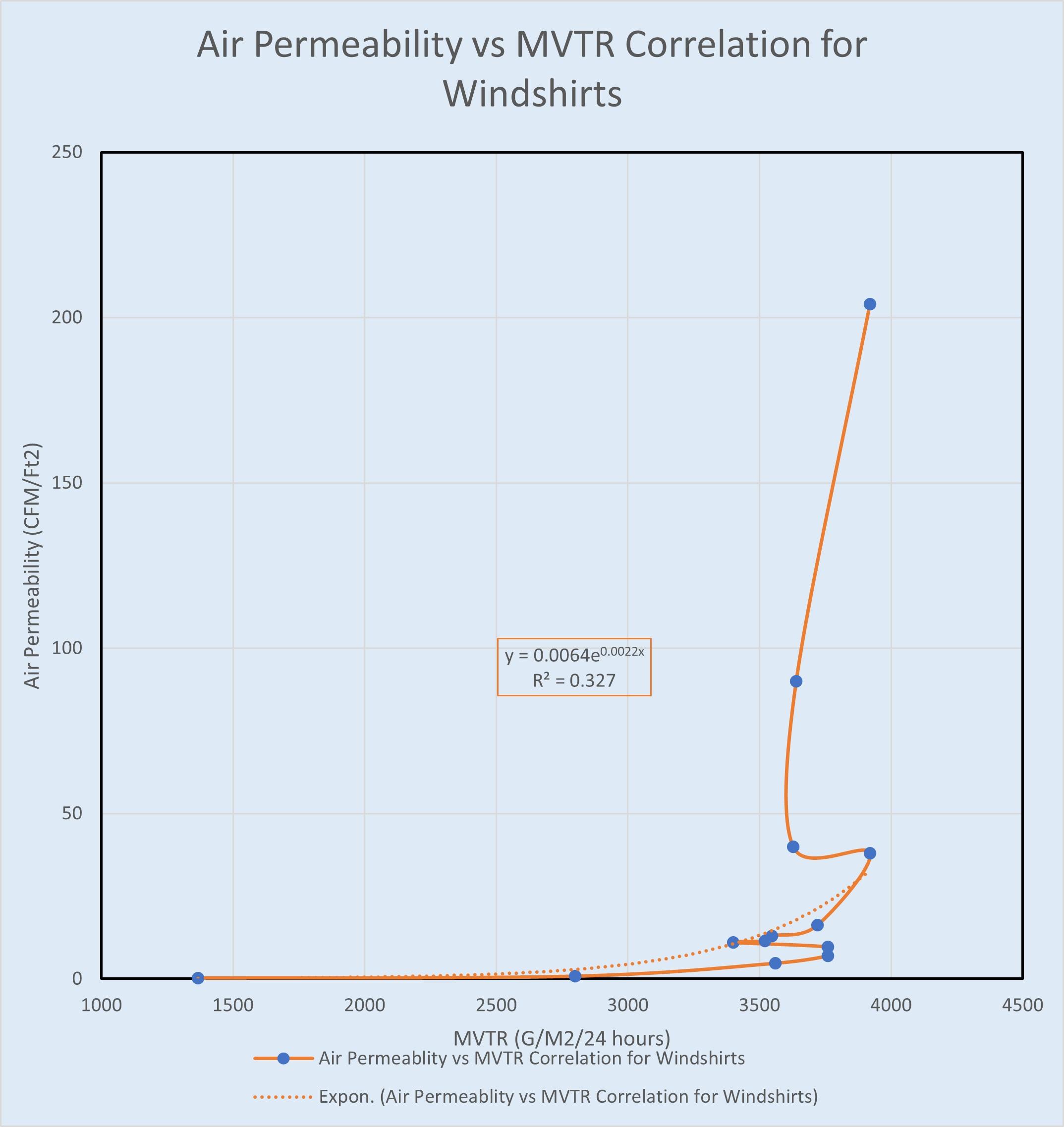Topic
By The Numbers Fabric Air Permeability and MVTR are Closely Related, Just Not How You Might Expect
Forum Posting
A Membership is required to post in the forums. Login or become a member to post in the member forums!
Home › Forums › Campfire › Editor’s Roundtable › By The Numbers Fabric Air Permeability and MVTR are Closely Related, Just Not How You Might Expect
- This topic has 12 replies, 5 voices, and was last updated 1 month ago by
 Tjaard Breeuwer.
Tjaard Breeuwer.
-
AuthorPosts
-
Jan 15, 2024 at 9:00 am #3801534
Companion forum thread to: By The Numbers Fabric Air Permeability and MVTR are Closely Related, Just Not How You Might Expect
This work explores the relationship between air permeability and MVTR in fabrics that do not include a waterproof membrane.
Jan 15, 2024 at 2:02 pm #3801591Another cool article. Thanks for continuing to pursue the science behind tech fabrics.
The correlation between CFM and MVTR may be useful when shopping, because CFM is easier to test and compare between labs and companies.
Jan 15, 2024 at 9:45 pm #3801619Exactly right. As long as there is no membrane.
Jan 16, 2024 at 5:52 am #3801623How did you score the airshed pro given that it’s two fabrics? The main material listed as pertex quantum air which is the same fabric (maybe different weights) as the kor preshell (airshell).
The airshell seems like a real winner given it retains some wind resistance but is among the highest in MVTR for the windshirts.
Jan 16, 2024 at 8:24 am #3801625Hi Kevin: The measurement is made for the Pertex fabric, not the knit sleeves and hood. As Scott Emmens pointed out on another thread, the fact that fabrics in different garments have the same name, doesn’t tell you anything about their performance. Pertex will make numerous different fabrics with the name Quantum Air.
Jan 16, 2024 at 8:58 am #3801627Yes I agree. I have a Rab Summit VR that is listed as a heavier weight quantum air that has even less cfm but still does not feel clammy or uncomfortable at higher intensity. It be great to see tests of different versions to see how they compare. It’s always frustrating when they don’t provide the same information about the fabric used to make comparisons. MHW lists it as 20D 59% recycled and Pata lists it as 1.5 oz 54% recycled.
Thank you as always for your efforts to provide more information on these very smoke and mirrors marketing issues.
Jan 17, 2024 at 9:33 am #3801740I was going to say the same thing as @Bill Budney when I started reading, that airpermeability is easier to find and compare, so it would be very useful if it could be used as a proxy for MVTR.
However, it turns out, as Stephen describes in the rest of the article, that for anything that might be considered a “shell” (meaning it blocks significant wind, and perhaps moisture), there is no no (useful) correlation.Ah well. We can only dream of a world where all garments were tested independently, and the ratings available before purchasing them..
Jan 17, 2024 at 4:19 pm #3801766Missing Correlation Data:
I took a look at this article and found that, somehow, the correlation equation and R2 value is missing for most of the correlation graphs. These data show very strong (with one exception) correlation between MVTR and Air Permeability.
I include these below with the missing data.
Figure 3:

Figure 4:

Figure 5:

Figure 6:

Figure 7:

I hope that helps to clarify my conclusions.
Jan 17, 2024 at 4:53 pm #3801775Hi Tjaard: I would like to comment on your conclusion about windshirts. There is little doubt from the data that in general, there is a good correlation between MVTR and Air Permeability. A group of fabrics used in some windshirts predicts less accurately than other portions of the data set. This is most easily seen using the Pearson correlation coefficient which can be applied to particular subgroups of the total dataset. The windshirts with the lowest air permeability (HyperD Calendered through Outdoor Vitals Nebo produce an R2 of .83, which is a decent predictor. The next group, Nebo to Mountain Hardware Kor, produces an R2 of only .21, which is not a good predictor. The next group, Hyper D Uncalendared to Alpha Direct 60 gsm produces an R2 of .95. A good predictor. If you use the overall correlation equation to predict MVTR based on Air Permeability, your greatest error will be in the second group of fabrics. However, the error in MVTR will be within 300 or so. This can be seen in Figure 7. The use of the correlation equations for garments with air permeability between approximately 10 and 38, where the most variance is present, will still yield a pretty good approximation of the expected MVTR. As I said in the article, there are other factors involved in this group of fabrics that influence behavior. However, the most important predictor of MVTR for the garments I tested is air permeability. Fundamentally, the most important predictor for both characteristics is fabric porosity. These relationships do not apply to fabrics using a membrane.
I hope this clarifies what to expect from the data. If not, post any questions, and I will try to answer them.
Jan 21, 2024 at 5:40 pm #3802092@Stephen Seeber.
Do I have this right that, in general, there is a correlation between CFM and MVTR due to porosity being the physical principle underlying both of these properties; but, vapour pressure and differential is the most crucial driver of moisture loss from skin? This explains how one can have a low cfm/high MVTR garment.
Secondly, as MVTR may be high where CFM is low, MVTR rating is most critical metric if moisture loss is the desired property of the garment?
Thirdly, CFM is not an independent metric of much value when considering the wind penetration of windshirts as it does not predict for wind penetration in normal circumstances (ie all of these garments block high cold wind). But, as high CFM correlates with MVTR, it is a good predictor for MVTR – all else being equal?
Therefore, (unless you know the MVTR of a garment) always pick a high CFM value in a windshirt, not because it exchanges air particularly well and will ‘breathe’, but because it will have a reasonable MVTR.
In corrolary, picking a low CFM windshirt is risky. Not because it is practically any worse at exchanging air (‘breathing’) than a high CFM garment, but because it is more likely to have a poor MVTR than a high CFM garment.
Great series of articles, much appreciated. They keep me a subscriber, by the way.
Edited for typos and clarity.
Jan 21, 2024 at 11:01 pm #38021041) Correlation between MVTR and Air Permeability means they rise (or fall) together. As one gets higher, so does the other. This is for fabrics without a membrane. The vapor pressure differential is critical to moisture vapor moving from the skin and through clothing fabrics.
2) I am not sure I understand your question.
3) I agree with the 1st part of your statement unless high winds are present. In that case, the outcome could be different. In the final part of this statement, I would remove the word “high”.
4) Corollary: I am not sure I would use the word risky, I would agree with the last portion of your statement.
Mar 23, 2024 at 6:33 am #3806184Thanks for that further explanation Stephen!
Mar 28, 2024 at 4:14 pm #3806565Stephen, you list an EE copper field jacket. Which fabric was that one? They have 7d, 10d and 20d options, at least in their custom option.
They list 35 cfm for the 7d so I assume this was either 10d or 20d? Was it a stock garment? Those are 10d.
-
AuthorPosts
- You must be logged in to reply to this topic.
Forum Posting
A Membership is required to post in the forums. Login or become a member to post in the member forums!
Our Community Posts are Moderated
Backpacking Light community posts are moderated and here to foster helpful and positive discussions about lightweight backpacking. Please be mindful of our values and boundaries and review our Community Guidelines prior to posting.
Get the Newsletter
Gear Research & Discovery Tools
- Browse our curated Gear Shop
- See the latest Gear Deals and Sales
- Our Recommendations
- Search for Gear on Sale with the Gear Finder
- Used Gear Swap
- Member Gear Reviews and BPL Gear Review Articles
- Browse by Gear Type or Brand.







